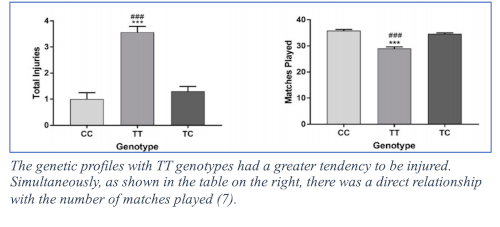Genetics and Sports
Nearly thirty centuries have passed since the first Olympic Games happened in ancient Greece, and we are still studying the factors that influence the best performance. Fortunately, nowadays, thanks to technology, we have a variety of biometric devices that measure every second (heart rate, muscle oxygen saturation, blood lactic acid levels, etc.). Evolution could have stopped there, but humankind always wants to go further. Today we look under our skin, in each of our cells, for answers: genetics.
Factors influencing sports performance
Many factors influence sport performance: diet, physiology, environment, psychology, and many other environmental parameters (1). Genetics in recent decades has shed light on a wide variety of sporting factors such as muscle performance, tendon injuries, or lung capacity (2). Considering these discoveries, most athletes train knowing their body based on their sensations and previous experiences but unaware of their unique predispositions based on their genetics (3).
Sport and DNA
In each of the cells, we carry is a molecule that contains part of your sporting potential. It is "hidden". To find it and decipher it, you will have to go to a laboratory where machines can read your DNA. And perhaps you will think, why am I explaining this to you? You see, by deciphering your DNA, you will know specific markers (genotypes). Through them, we can understand your sporting tendencies: if you are a person with a greater capacity for endurance, or if you have a greater tendency to get injured or if, on the other hand, you have an unfavourable profile in terms of power (phenotypes).
Endurance and PPARGC1A gene
And it goes further, recent genetic studies on people who play rugby, depending on their position on the field, carry a different genetic profile (4). And what about endurance? Five years ago, a meta-analysis evaluated the role of the PPARGC1A gene, a gene recognized for its fundamental role in resistance. Among the released findings, people who experienced better resistance performance carried a particular allele[1] (GC and CC). At the same time, GG genetic profiles showed no such genetic advantage in version (5).
Discoveries such as this have produced a cascade of research carried out by the scientific community. Thus, research continues and diversifies through many channels. Injuries are another striking field and one of the primary headaches of many sports clubs and athletes worldwide. Leaving genetics aside and not paying attention is certainly not a good idea if you want to get the most out of yourself in the sport you choose to practice (6).
Injuries and genetics

Two years ago, another study, this time focused on the genetic tendency to injury and its relationship with genes such as COL5A1 or AMPD1. Among the conclusions, as you can see in the chart the study revealed how specific individuals (genetic profiles) were related directly to the genetic tendency to injury (7).
Not only injuries and sports endurance are the only factors that are currently in the study. We know how different genes directly influence bone density or how fast and slow-twitch muscle fibres interact. Knowing the blind spots of your genetics up close is starting on a path that few people still know. However, the potential for improving your performance is infinite.
If you feel like deciphering the potential advantages your DNA holds, stop by our store and find out: https://24genetics.com/en/dna-shop/sports-adn
[1]Each of two or more alternative forms of a gene that arise by mutation and are found at the same place on a chromosome.
Bibliografía:
- Lippi, G. et al. Genetics and sports. Br Med Bull. 2010;93:27-47. doi: 10.1093/bmb/ldp007. Epub 2009 Feb 9. PMID: 19208613.
- Elaine, A., et al. Genetics of Athletic Performance Annual Review of Genomics and Human Genetics. Vol. 10:407-429 (Volume publication date September 2009). First published online as a Review in Advance on July 16, 2009. https://doi.org/10.1146/annurev-genom-082908-150058.
- Hay, J. A Gene Ahead of the Game: A Look at Sports Genetics. 2017. AGAMassidda, M. et al. Sports, Exercise, and Nutritional Genomics, Chapter Five - Genetics of team sports, Academic Press, 2019, Pages 105-128, SBN 9780128161937, https://doi.org/10.1016/B978-0-12-816193-7.00005-1.
- Lopez-Leon, G., et al. Sports genetics: the PPARA gene and athletes' high ability in endurance sports. A systematic review and meta-analysis. 2016. Biology of sport, 33(1), 3–6. https://doi.org/10.5604/20831862.1180170.
- Pruna, R., et al. Influence of Genetics on Sports Injuries. 2017. J Nov Physiother 7:359. Doi: 10.4172/2165-7025.1000359.
- McCabe, K. and Collins, C. Can Genetics Predict Sports Injury? The Association of the Genes GDF5, AMPD1, COL5A1 and IGF2 on Soccer Player Injury Occurrence. Sports (Basel). 2018 Mar 5;6(1):21. doi: 10.3390/sports6010021. PMID: 29910325; PMCID: PMC5969195

